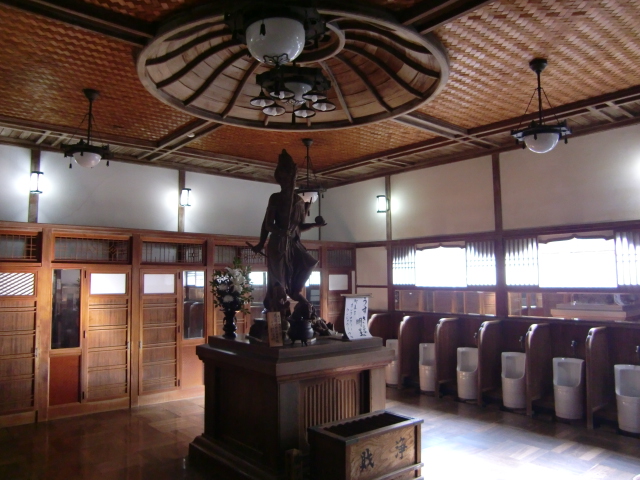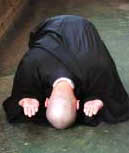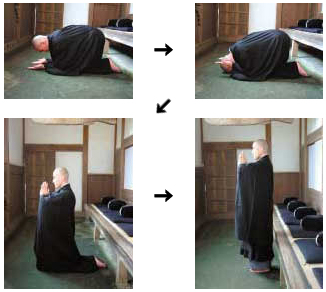After monks began to reside in temple quarters, they constructed a building that they referred to as ‘the Eastern Quarters’. Sometimes it was called a water closet and at other times a lavatory. It is absolutely essential to have a lavatory in a place where a family of monks resides.
When going to the Eastern Quarters, you should be sure to take a hand towel with you. The way to do this is to fold the hand towel in half and put it over your left shoulder, letting it hang down over the sleeve of your gown. When you have arrived at the Eastern Quarters, you should hang your towel over the clean-clothes pole. Hang it in the same way it was when it was hanging on your shoulder.
If you come wearing a nine- or seven-striped kesa,* you should be sure to hang it next to your towel. You should hang it so that it will not fall off. Do not hastily toss it over the pole. You should be sure to pay particular attention to the name marker. The name marker is for putting your name on the pole. Write your name on a piece of white paper in the shape of a full moon and then align this marker on the rack. We use a name marker so that we will not forget where we have put our robe. When our monks come in numbers, we must be sure not to confuse our place on the rack with that of others.
If a number of monks come and line up at this time, make shashu* and bow in greeting to the others. When bowing in greeting, you need not bow deeply: simply hold your hands in shashu before your chest and bow in recognition of the others. When in the Eastern Quarters, we acknowledge the monks assembled by bowing to them even when we are not in our robes. If your two hands are not occupied or you are not carrying something in them, you should keep them in shashu and bow.
If one of your hands is already occupied, or when you are carrying something in one hand, you should make your bow with a one-handed gasshō.* In bowing with a one-handed gasshō, the hand is raised, with the fingers slightly cupped as if you were going to use the hand to scoop up water; the head is lowered slightly, as in greeting. When another monk behaves in this way towards us, we should behave similarly: when we behave in this way, the other monk should do likewise.
The procedure for taking off your undershirt and outer robe is to remove your robe along with the undershirt by bringing the two sleeves together in back, putting the two arm holes together, and lifting up the sleeves. You then fold the two sleeves, one atop the other, over the garment. Next, with the left hand, grasp the back of the collars and, with the right hand, draw up the robe and fold it down the middle of the sleeve bags7 and the two collars. Having folded over the two sleeves and collars, you again fold the robe in two, lengthwise, and drape it over the pole with the collars on the far side; the skirt of the robe and the sleeve cuffs hang on the near side of the pole. That is to say, the robe hangs at the waist over the pole.
Next, avoid mistaking whose towel is whose when there are two poles and two towels are hanging one in front of the other. So that your towel does not get separated from your robe or get taken by someone who has not hung up a towel, tie it down by wrapping it around your robe two or three times and tying it, without letting your robe fall onto the ground. Then, facing your robe, you make gasshō.
Next, you take a sash cord and hang it over your shoulders. Then go to the wash stand and fill a clean bucket with water; carrying the bucket with your right hand, go into a toilet stall. In putting water in the bucket, do not fill it to the brim, but fill it up nine-tenths of the way.
When you reach the lavatory door, you should change your slippers. Put on a pair of rush slippers, leaving your own slippers by the front of the lavatory door. This is what is meant by ‘changing slippers’.
It says in the Procedures for Cleanliness in a Zen Temple, “When you need to go to the Eastern Quarters, by all means anticipate this need. Deal with it in time, so that you do not hurry from urgency. Give yourself time to fold your kesa, and leave it on your table in the Monks’ Quarters or on the clean pole in the lavatory.”
Upon entering the toilet stall, close the door with your left hand. You next pour just a little water from your bucket into the toilet basin. Next, put the bucket in front of you in the place provided for it. Then, while standing, face the basin and snap your fingers three times. Whilst snapping your fingers, your left hand is held in a fist at your left side at waist level. Next, you lift and gather up your under-skirt by its corners, face the door and, straddling the basin between your feet, squat down and relieve yourself. Do not soil either side of your garments; do not let them get stained front or back. During this time, you should remain silent. Do not talk or joke with the person in the next stall, chant, sing, or recite anything aloud. Do not spit or blow mucus from your nose onto the area around you. Do not strain or make grunting sounds excessively. You should not write on the walls. Do not dig at or draw on the ground with your toilet spatula; it should be used for cleaning yourself after you have evacuated your bowels. Also, if you use paper, you should not use old paper or paper with characters written on it.
You should keep in mind the difference between a clean spatula and a soiled one. The spatula is eight inches long, triangular in shape. In thickness, it is the width of one’s thumb. Some are lacquered, others are not. Put your soiled spatula in the used spatula box. Clean ones will already be in the spatula stand. The spatula stand is kept near the sign in front of the toilet basin. After using a spatula or paper, the way you clean yourself is as follows: hold the bucket in your right hand and moisten your left hand well. Then, cupping some water in your left hand, you first clean off your genitals three times. Then, you wash your buttocks. This is the way you should clean yourself.
Do not tip the bucket roughly, spilling the water into your hand and quickly using it all up. After you have finished cleaning yourself, put the bucket down in its proper place; then, take the used spatula and wipe it clean and dry with paper. You should wipe your genitals and buttocks dry. Next, adjust your under-skirt and robe with your right hand, and, also with your right hand, pick up the bucket. Then go out the door, take off the rush slippers, and put on your own. Next, you return to the wash stand and put the bucket in its original place.
Next, you should wash your hands. With your right hand you take a spoonful of ashes, place it atop some pebbles, drip some water on them, and wash your contacting hand with your right hand,9 using the pebbles to scour it, just as though you were cleaning rust off a sword. You should wash with ashes in this manner three times. Then, you should take some sand, add some water, and wash three times. Next, take some cleansing powder made from ground orange seeds in your right hand, moisten it with water from the small bucket, and wash by rubbing your hands together. The washing should be done thoroughly, even up your forearms. You should wholeheartedly devote your attention to washing in a conscientious manner. Ashes thrice, sand thrice, and cleansing powder once—all together seven times, an appropriate number. Next, you wash in a large bucket. This time, you simply wash in cold or warm water, without using any cleanser, sand, or ashes. After washing once, transfer that water into the small bucket, put in fresh water, and rinse both hands. In the Avatamsaka Scripture, a verse says:
When washing your hands,
By all means pray that all sentient beings
May acquire the finest hands
With which to receive the Buddha’s Teachings.
When you use a water ladle, you should, of course, hold it with your right hand. When using it, do so quietly, without making a great noise with bucket or ladle. Do not splash water about, scatter the cleansing powder, or get the area around the water stand wet. That is to say, do not be hasty or careless: do not be disorderly with things or treat them roughly.
Next, you dry your hands with the towel for general use or dry them with your own towel. Once you have finished drying your hands, go to where your robe is hanging over the pole, undo the sash cord, and hang the cord over the pole. Next, hang your towel over your left shoulder and rub some incense on yourself. There is rubbing incense for general use. It is made of fragrant wood in the shape of small vials. The size of each is about the thickness of a thumb and four times that amount in length. You take a piece of string about a foot long and thread it through the holes that are bored in each end of the incense stick. This is hung over the pole. When you rub it between the palms of your hands, the fragrance of this incense will naturally impregnate your hands.
When you hang your sash cord over the pole, do not hang it over another one so that they become entangled, and do not leave it in a disorderly fashion.
When matters are handled in this way, everything will be a purified Buddha Land, a Buddha World well adorned. You should do everything with care, without a lapse: you should not act from haste, as though in a dither. Do not entertain the thought, “If I hurry, I can get back to what I was doing.” You should keep in mind the principle that, when you go to the Eastern Quarters, the Buddha’s Dharma is not something to be talked about, but lived.
Do not stare at the faces of monks coming and going.
In cleansing yourself whilst in the lavatory, it is fine to use cool water, since it is said that hot water may cause diarrhea. Using warm water to wash your hands will not prove disturbing to your health. A kettle has been provided for heating water to wash your hands with.
Concerning the duties of the monk in charge of the lavatory, it says in the Procedures for Cleanliness in a Zen Temple, “Later in the evening, see that water is heated and oil is put out for the night lamp. Always make sure that there is someone to take over the boiling of the water, and do not let the community do it with a discriminatory attitude.” From this it is clear that both hot and cold water are used.
If the interior of the lavatory becomes dirty, you should screen off the entry door and hang the sign that says ‘Dirty’ on it. If a bucket is accidentally knocked over, you should screen off the entry door and hang up the ‘Spilled Bucket’ sign. Do not enter the building when such signs have been put up.
Even though you may have already entered a stall, if there is someone else who snaps his fingers to let you know of his presence, you should leave shortly.
http://www.thezensite.com/ZenTeachin...o/007senjo.pdf





 Reply With Quote
Reply With Quote





































